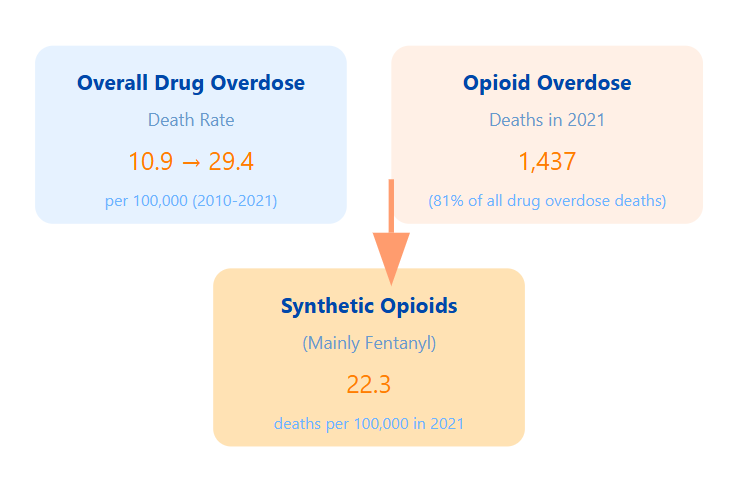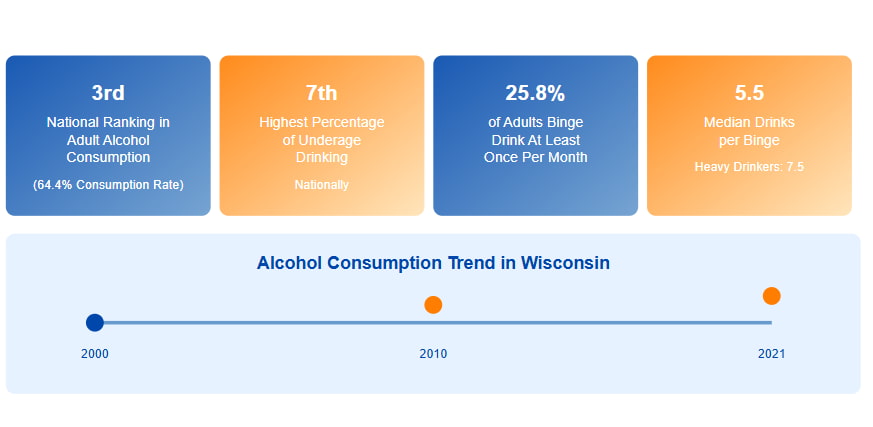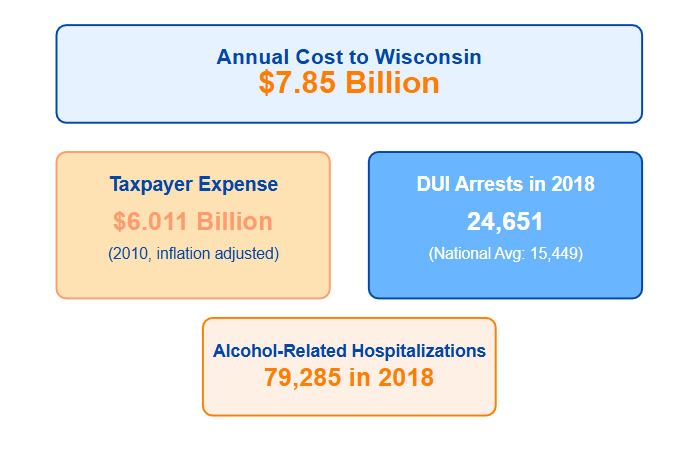Statistical Data on Drugs in Wisconsin
Wisconsin faces significant challenges with substance use, particularly with alcohol and opioids. The state has seen a dramatic increase in drug overdose deaths over the past decade, with particularly concerning trends in synthetic opioid-related fatalities. While some substance use rates remain below national averages, certain demographics show elevated risk patterns, and access to treatment remains a critical challenge.
Overdose Deaths and Mortality
- Drug overdose death rate increased from 10.9 per 100,000 (2010) to 29.4 per 100,000 (2021)
- 1,437 opioid overdose deaths in 2021 (81% of all drug overdose deaths)
- Synthetic opioids (mainly fentanyl) caused 22.3 deaths per 100,000 in 2021 (20-fold increase since 2010)

Opioids Factor in Overdose Deaths
- Prescription opioids: 35.6%
- Heroin: 38.7%
- Synthetic opioids: 59.8%
- Total overdose deaths involving opioids: 78.4%
The sharp increase in overdose deaths, particularly from synthetic opioids, indicates a worsening crisis that has accelerated during the pandemic years.
Drug Overdose Trends
| Year | Total Drug Overdose Deaths per 100,000 |
| 2010 | 10.9 |
| 2014 | 14.9 |
| 2018 | 19.3 |
| 2020 | 25.9 |
| 2021 | 29.4 |
The trend data reveals a consistently rising trajectory of drug overdose deaths. There is a nearly threefold increase, underscoring the escalating severity of the substance use crisis.
Drug Use Prevalence
Overall Drug Use Rates
- Illicit drug use in past month: 13.14% of population aged 12+
- Marijuana use in past year: 16.62% of population aged 12+
- Cocaine use in past year: 1.95% of population aged 12+
- Methamphetamine use in past year: 0.66% of population aged 12+
The data reveals marijuana as the predominant illicit drug, with significantly higher usage compared to cocaine and methamphetamine. The 16.62% marijuana use rate among those aged 12+ indicates widespread consumption, particularly among younger age groups who demonstrate the highest rates of drug use.
Substance Use by Age Group
Youth (12-17 Years)
- 7.5% use drugs currently
- 6.5% used marijuana in the past month
- 30.6% have used marijuana in their lifetime
- 11.2% have misused prescription pain medications
- 13.7% were offered, sold, or given illegal drugs on school property
- 1.9% misused pain relievers in the past year
The youth statistics are particularly concerning. The numbers suggest early exposure and potential long-term substance use risks. The high percentage of school drug exposure indicates that substance availability is a significant issue in educational environments.
Young Adults (18-25 Years)
| Measure | Percentage |
| Past-year marijuana use | 29.8% |
| Marijuana use disorder | 4.4% |
| Opioid use disorder | 0.7% |
| Substance use disorder | 17.1% |
Young adults show particularly high rates of binge alcohol use compared to national averages, indicating a significant public health concern.
Substance-Specific Highlights among Students
Marijuana
- 24.8% of students have used marijuana
- 4.2% tried marijuana before age 13
- 13.6% used marijuana in the past 30 days
Prescription Medications
11.2% of students misused prescription pain medications
The statistics indicate significant substance use among students, with marijuana usage being particularly high at 24.8% lifetime use and 13.6% recent use, alongside notable prescription medication misuse at 11.2%.
Past-Year Substance Use (12 Years and Older)
- Marijuana: 13.2%
- Heroin: 0.48%
- Prescription painkiller misuse: 3.9%
- Past-year substance use disorder: 7.7%
The prevalence data provides a broader view of substance use across the population. While marijuana use is relatively high, the prescription painkiller misuse rate suggests ongoing challenges with prescription drug abuse.
Substance Use Treatment
- Total People in Substance Use Treatment (2019): 25,574
- Opioid Treatment Program Enrollment: 5,183
Treatment Program Breakdown
- 42.5% drug problem only
- 36.6% both drug and alcohol problems
The treatment statistics reveal the complexity of substance use disorders. Over a third of individuals in treatment struggle with both drug and alcohol problems, highlighting the interconnected nature of substance abuse and the need for comprehensive treatment approaches.
Treatment Access and Facilities
| Category | Number |
| Active substance abuse clinics | 327 |
| Annual clients served | 25,574 |
| Outpatient service clients | 23,945 |
| Residential treatment clients | 1,329 |
| Hospital-based clients | 300 |
| Facilities offering free treatment | 2 |
The data shows a significant gap between treatment need and availability, with only a small number of facilities offering free treatment options.
Cost of Treatment
- Outpatient: $1,708
- Residential: $56,625
The high cost of residential treatment may present a significant barrier to access for many individuals needing care.
Prevention Programs
- Universal direct: 59.6%
- Universal indirect: 22.6%
- Selective: 8.5%
- Indicated: 8.5%
Most prevention efforts focus on universal direct interventions, reaching identifiable groups without known risk factors.
Demographic Distribution in Prevention Programs
| Race/Ethnicity | General Population % | Program Reach % |
| White | 80.4% | 73.64% |
| Hispanic/Latino | 7.6% | 8.57% |
| Black/African American | 6.4% | 6.58% |
| Asian | 3.0% | 2.52% |
| American Indian/Alaska Native | 1.0% | 1.23% |
Prevention program reach generally aligns with population demographics, though some disparities exist in access and utilization.
Wisconsin’s substance use landscape is complex, with persistent challenges across different substances, age groups, and communities. Continued focus on prevention, treatment, and addressing underlying social factors remains crucial.
Statistical Data on Alcohol in Wisconsin
Wisconsin stands out as a state with significant alcohol consumption and related challenges. The data reveals a complex picture of alcohol use across different age groups, with high rates of binge drinking, alcohol-related deaths, and substance use disorders that often exceed national averages.
General Insights
- Wisconsin ranks 3rd in the country for adult alcohol consumption (64.4%)
- 7th highest percentage of underage drinking nationally
- 25.8% of Wisconsin adults binge drink at least once per month
- Median of 5.5 drinks per binge, with heavy drinkers consuming 7.5 drinks

These insights underscore Wisconsin’s national reputation for heavy drinking, highlighting a cultural acceptance of alcohol consumption that spans across age groups and social contexts.
Alcohol-Related Deaths and Mortality
- Total annual alcohol-attributed deaths: 2,651 (data point) to over 3,300 (by 2022)
- 142% increase in alcohol-induced deaths statewide from 2000 to 2020
- 24.5% year-over-year jump in alcohol-induced mortality in 2020 during COVID-19 lockdowns
- Death rate increased from 6.7 to 18.5 per 100,000 residents (2000-2020)
- 64,214 years of potential life lost to excessive alcohol use each year
Death Demographics
- 68.4% of people who die from excessive alcohol use are male
- 63.2% of deaths are from chronic causes, such as Alcohol Use Disorder
- 86.1% of deaths are adults aged 35 years and older
- 2.30% of deaths are individuals under age 21
The mortality data show a troubling upward trend, with alcohol-related deaths more than doubling over two decades. The pandemic appears to have exacerbated this trend significantly. The demographic pattern shows that while youth drinking is concerning, the mortality burden falls primarily on older, long-term users.
Alcohol Use Disorder Statistics
| Demographic | Alcohol Use Disorder Rate |
| Overall Population (12+) | 6.4% |
| Young Adults (18-25) | 13.6% |
| Treatment Needs | 10.69% not receiving specialized treatment |
The high rates of alcohol use disorder, particularly among young adults, are concerning. The significant percentage of individuals not receiving specialized treatment suggests a critical gap in addressing alcohol dependency.
Youth and Young Adult Alcohol Use
Youth (12-17)
Past-month alcohol use decreased from 23.2% (2002-2004) to 9.9% (2017-2019)
- 16.5% of students had their first alcoholic drink before age 13
- 25.7% of students currently drank alcohol
- 2.6% of students reported having 10+ drinks in a row within a couple of hours in the past 30 days
Young Adults (18-25)
- Past-month binge alcohol use: 42.9% (2017-2019), down from 46.7% (2015-2017)
- Past-year alcohol use disorder decreased from 25.3% (2002-2004) to 13.6% (2017-2019)
Underage Drinking
- Wisconsin has the 7th highest percentage of underage drinking nationally
- 18.89% of those aged 12-20 reported alcohol use in the past month
While youth alcohol consumption has shown positive decreasing trends over time, Wisconsin still ranks poorly compared to other states for underage drinking. The high percentage of students who began drinking before age 13 suggests early intervention programs may be necessary.
Binge Drinking Patterns
| Demographic | Binge Drinking Rate | Analysis |
| Overall Adults | 25.99% | 24% in 2018, compared to 16% national average |
| Young Adults (18-25) | 39.72% | 42.9% in 2019, higher than 35.4% national rate |
| Youth (12-17) | 5.34% | Declining trend over recent years |
Binge drinking is a significant concern, with Wisconsin far exceeding national averages. Young adults show particularly high rates, indicating a potential cultural normalization of heavy drinking that begins in late adolescence.
Economic and Social Costs
- Annual cost to Wisconsin: $7.85 billion
- Taxpayer expense: $6.011 billion (2010, adjusted for inflation)
- Alcohol-related hospitalizations: 79,285 in 2018
- DUI arrests: 24,651 in 2018 (vs. national average of 15,449)

The enormous economic burden demonstrates that alcohol abuse extends beyond individual health, impacting the entire state through healthcare costs, lost productivity, and law enforcement expenses.
The data paints a concerning picture of alcohol use in Wisconsin. The state consistently shows higher rates of alcohol consumption, binge drinking, and alcohol-related health issues compared to national averages. While there are some positive trends among youth, such as declining alcohol use, the overall landscape suggests significant challenges with alcohol abuse across different age groups.
In general, there is a complex substance abuse landscape in Wisconsin, characterized by significant challenges across multiple drug categories, with marijuana and opioids emerging as primary concerns. Young adults (18-25) demonstrate the highest vulnerability to substance use disorders, highlighting the critical need for targeted prevention and treatment strategies. The escalating trends in drug overdose deaths, particularly from synthetic opioids, underscore the urgency of addressing the state’s substance abuse crisis.
Sources:
- Drug Abuse Statistics
- 2022 Annual Report to the Governor on Activities Relating to Substance Abuse Prevention and Treatment
- WISCONSIN – National Survey on Drug Use and Health
- Mental Health and Substance Use State Fact Sheets: Wisconsin | KFF
- Explore Illicit Drug Use – Youth in Wisconsin | AHR
- Substance Misuse | City of Milwaukee
- The Latest Drug Addiction Statistics in Wisconsin
- Drug Addiction Hotline Wisconsin
- Behavioral Health Barometer: Wisconsin, Volume 6
- Wisconsin Substance Abuse Statistics | Lakeview Health
- How substance use disorders are impacting Wisconsinites